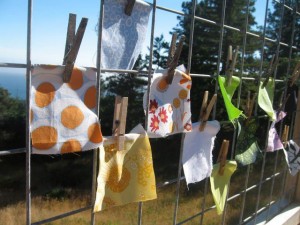You may not know this about me yet, but I’m a fabric junkie. In fact, when I finished my book last winter, my reward was a day-trip to New York City to shop at Mood Designer Fabrics. I need rehab.
So when Harmony Susalla contacted me to ask if I’d do a guest post on her blog, I jumped at the chance — and I asked her to do an interview with me. Harmony is a wonderful textile designer, who works in organic cotton.
Can you explain what you do for a living?
As a textile designer I create patterns and designs that are printed on fabrics. Since 2005, I have owned my own organic-cotton fabric company.
When do you use basic math in your job?
For a design to be printable using rotary screens, the design has to fit a particular circumference of the screens. Typically the circumferences are 25.25″ or 36″. So I use division on a regular basis because I need the repeat of the design to fit into a number that is divisible into the circumference size. For example: If I am using a 36″ screen then, depending on the size of the motifs, the repeat may end up being 18″ or 12″ or 9″ or 6″ or 4.5″ — or even smaller — but it must be a factor of 36.
I remember quite a few years ago I was working for a design firm and we had to do a diagonal stripe that repeated. I was doing it the hard way, meaning I would make manual adjustments, test, readjust, and test again until it eventually worked out. My colleague and friend at the time, Freya, went home and came back the next day with a formula. I was VERY impressed and still have that piece of paper with the formula on it. I still reference it. But it helped me to realize that with the use of basic math skills, I could save a lot of time and effort in my work, and ensure the quality of the final design.
Also, as a small business owner, I am constantly using math to calculate charges, create order estimates, figure out cost and profit margins, determine MSRPs (manufacturer’s suggested retail price), etc.
Do you use any technology to help with this math?
Just last week, I made a spreadsheet of all of the various repeat sizes for the 25.25″ screen size. One of my customers sent me a design she wanted printed, but the design was not created in an appropriate repeat size. I had to use the list I created in Excel to find the closest repeat-size option for her design and make the necessary adjustments.
I use QuickBooks to generate invoices which does basic multiplication and addition for me. I also use Excel on a fairly regular basis.
How comfortable with math do you feel?
On a scale of 1 to 10, I’d rate myself a 5. I am really comfortable with simple math. Work math seems natural. I actually really enjoy having math I learned in school apply to my daily life. So much of our formal education is forgotten because we just don’t use it, but I get to use math on a daily basis.
What kind of math did you take in high school?
In high school, I was always in the advanced math classes. My senior year, I was placed in calculus. Until that point, math had been pretty easy for me, but suddenly I was lost. I think I lasted about 2 weeks before I dropped the class. It was the first time I can remember truly feeling “stupid.” I was then placed in regular senior math, and it was so easy that I was held after class by my teacher who believed I had an attitude problem. While the teacher would go over homework from the day before I would be working on the current night’s homework. I would finish before class was over, and then stare out the window (because I didn’t need help). This was the behavior that convinced her I had an attitude problem. After that, I had to pretend to be paying attention to the lesson being taught, even though it was material I already knew.
Did you have to learn new skills in order to do the math you use today?
This is a good question. I think that most of the math I use today I learned in school, with the exception of some of the accounting terminology and applications that were new to me. But because I had a good base in math, it was relatively easy to learn on my own.
This entire week will be devoted to fabrics. Come back on Wednesday to see what I wrote for Harmony’s blog. On Friday, I’ll show you how I made some gorgeous curtains for my new living room out of Harmony’s Evelyn print.
In the meantime, post your questions for Harmony here. She’s happy to respond!

